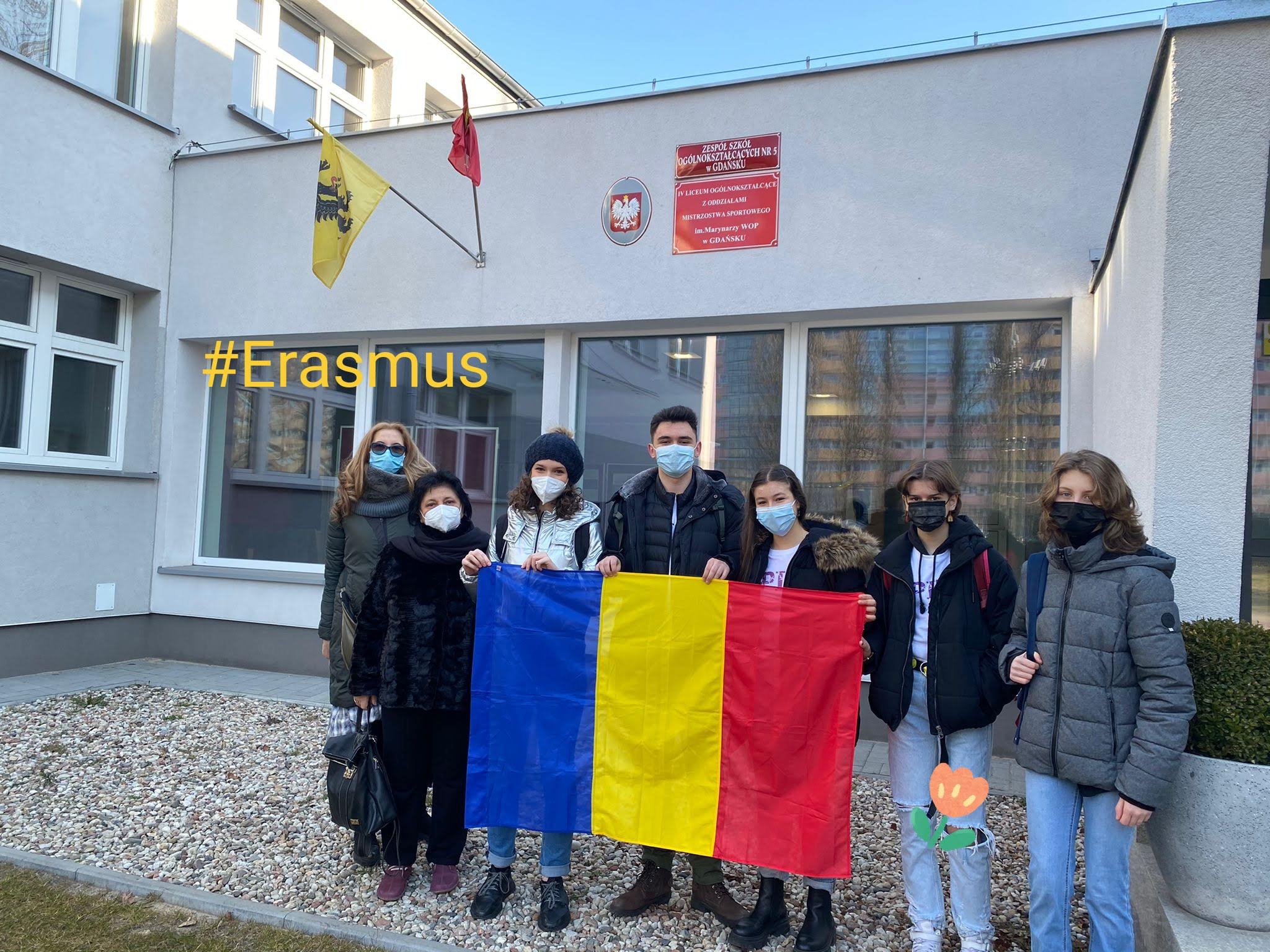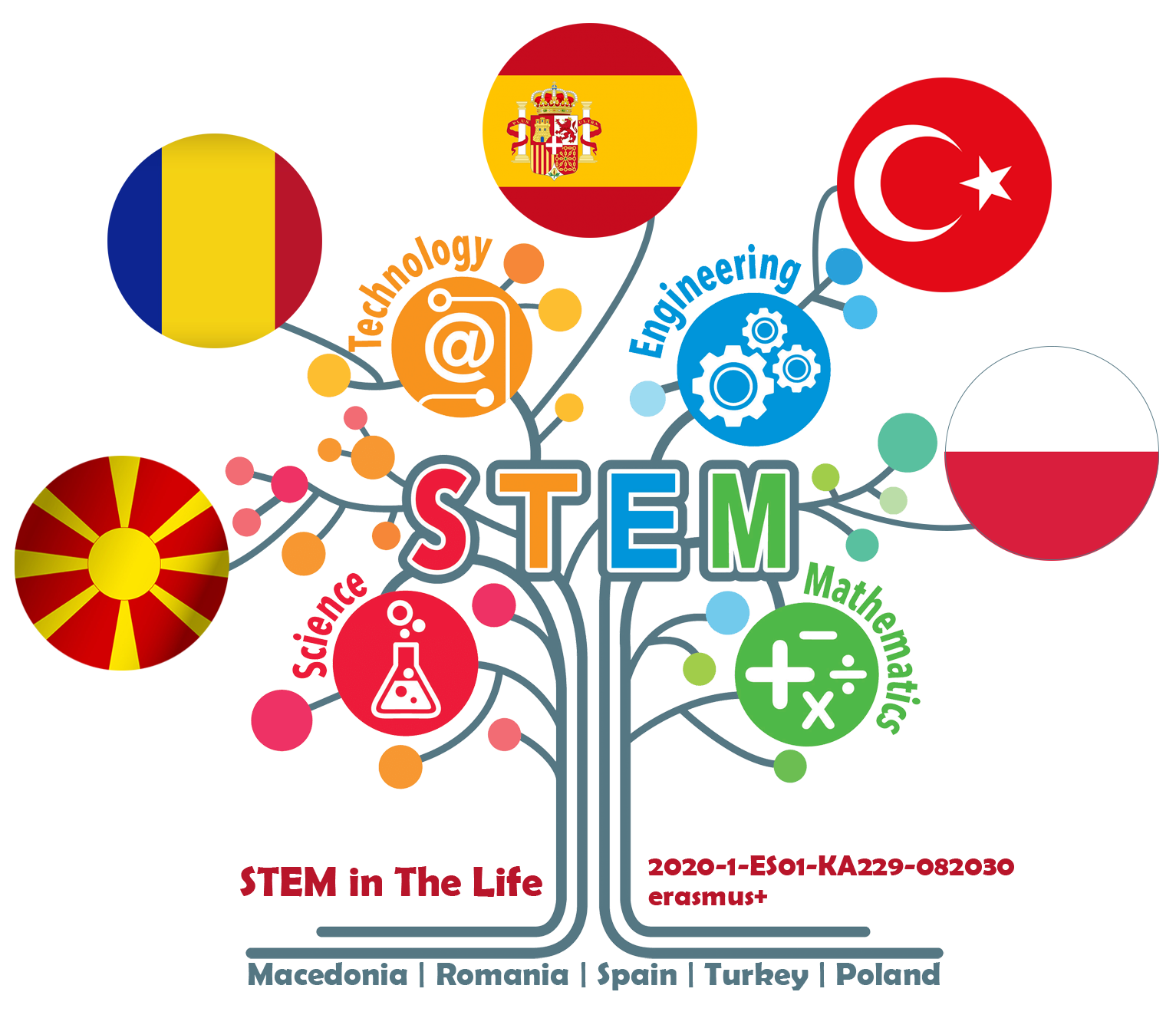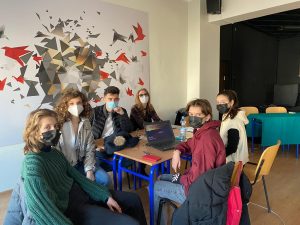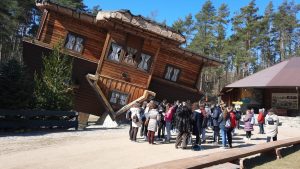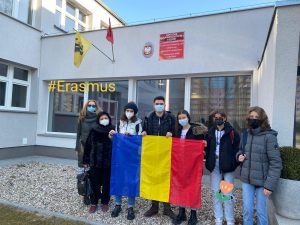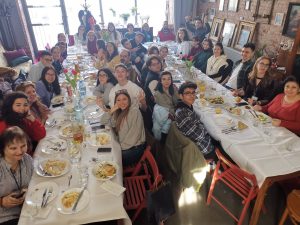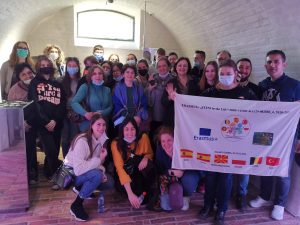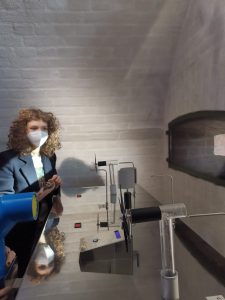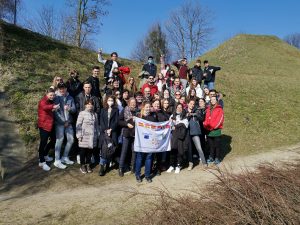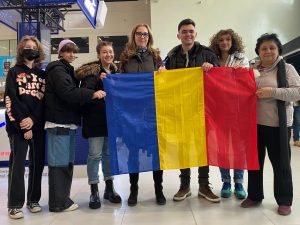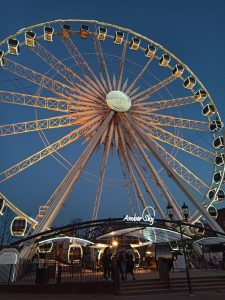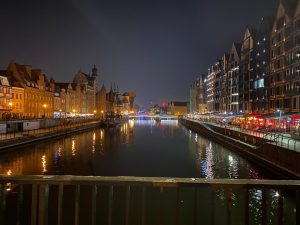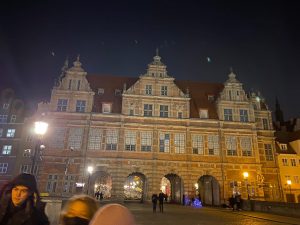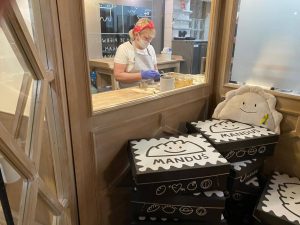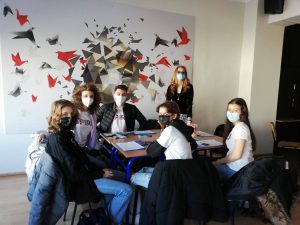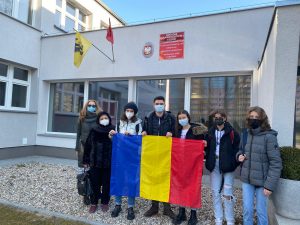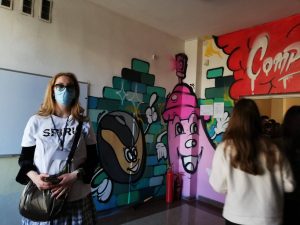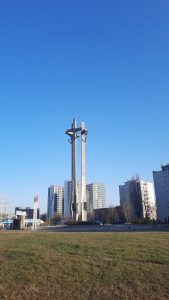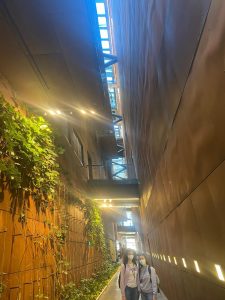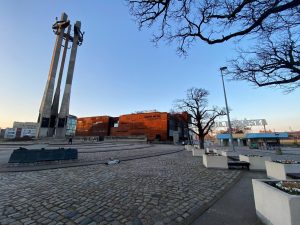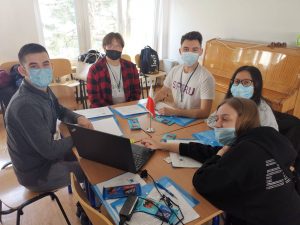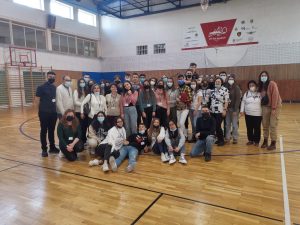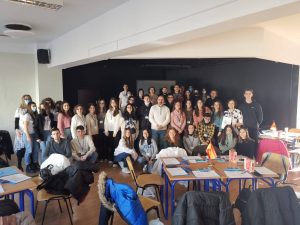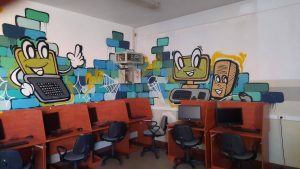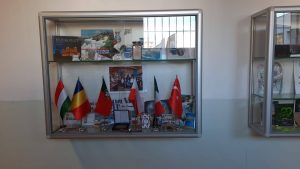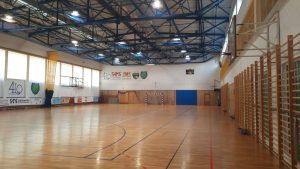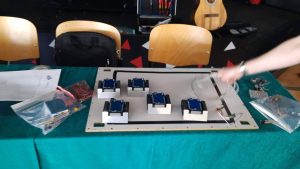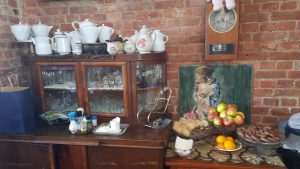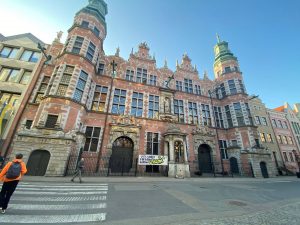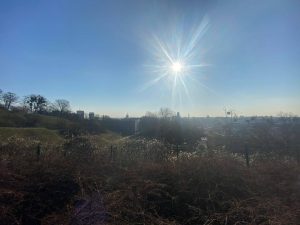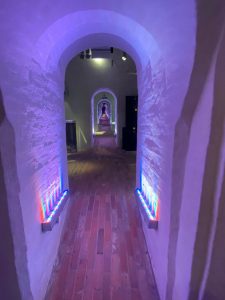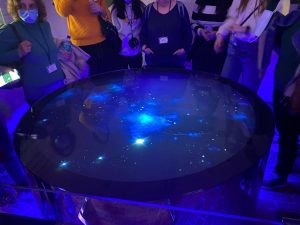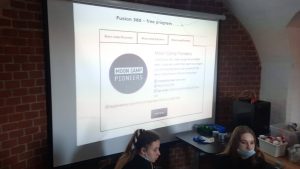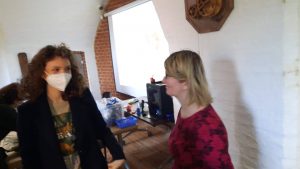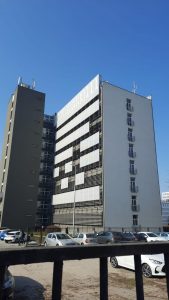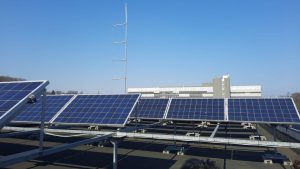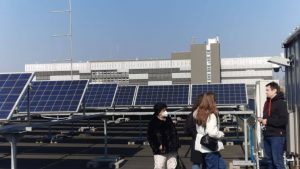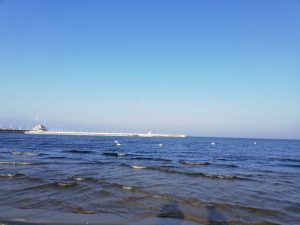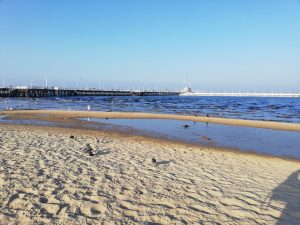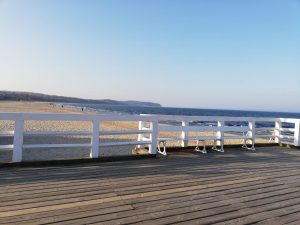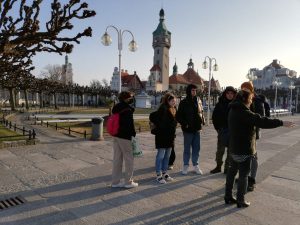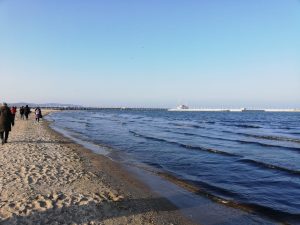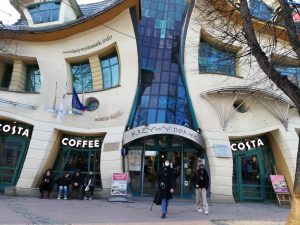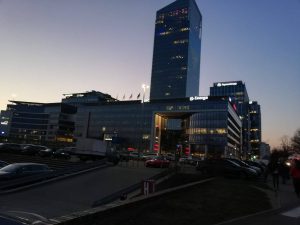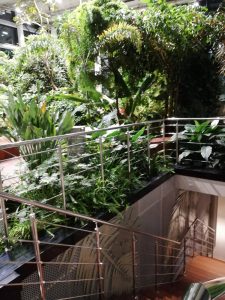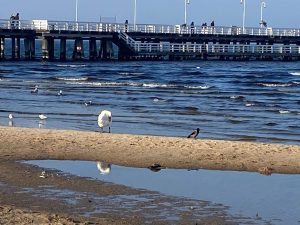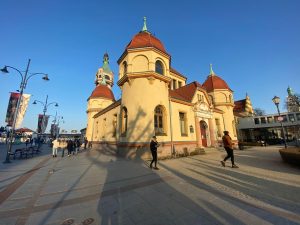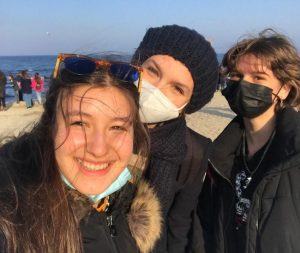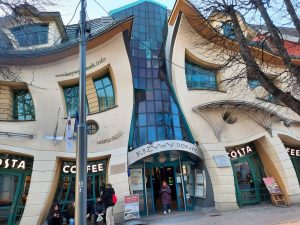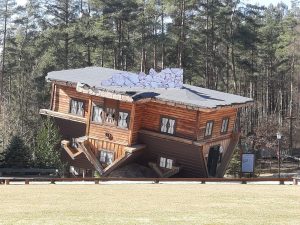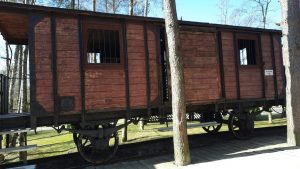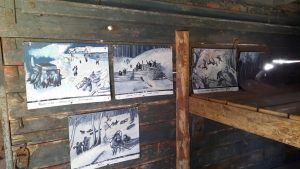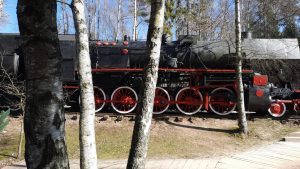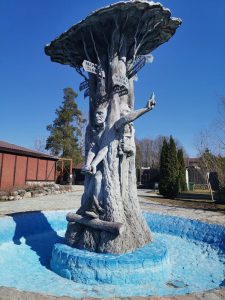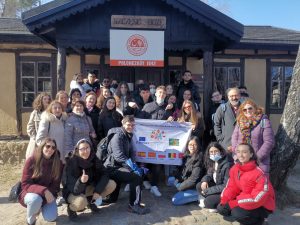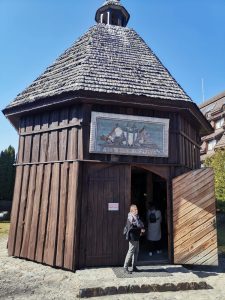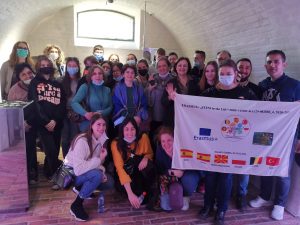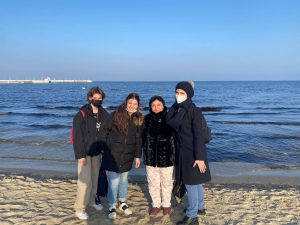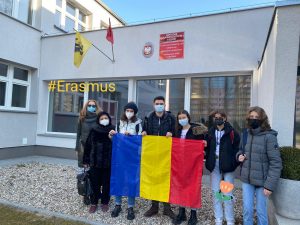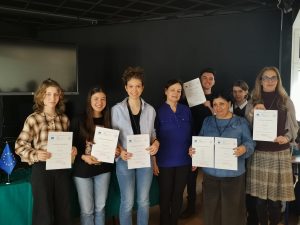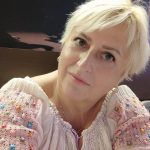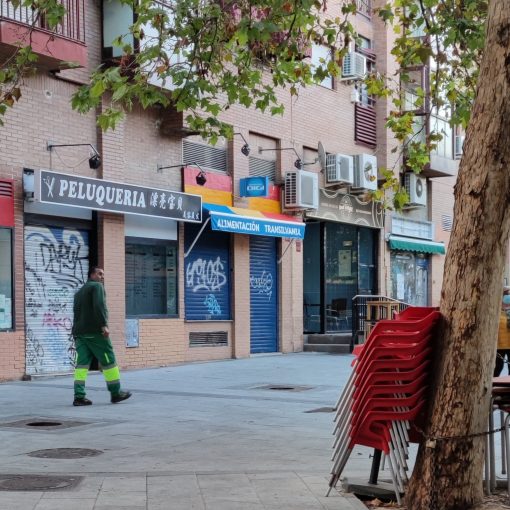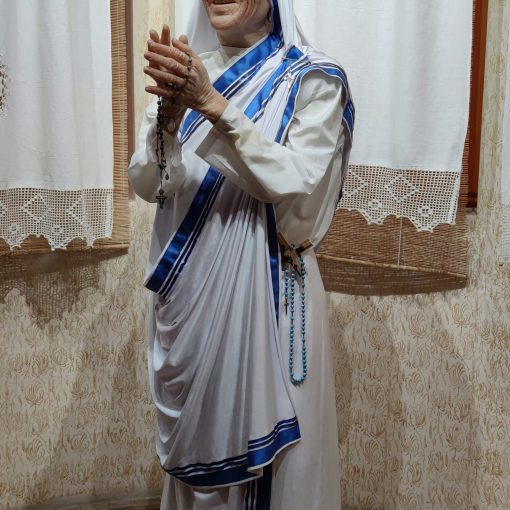| ZIUA 1: În prima zi a vizitei în Polonia în cadrul proiectului STEM IN THE LIFE Erasmus+, am mers la școala parteneră din proiect: ZespoI Szkol Ogolnoksztalcacych nr 5 IV Liceum Ogolnoksztalcace z Oddzialami Mistrzostwa Sportowego im. Marynarzy WOPschool cu tramvaiul. Aceasta avea să fie o călătorie zilnică, care ne permitea să traversam orașul matinal rapid, într-un mod interesant. După ce am fost primiți cu căldură de conducerea al școlii, am fost duși într-un tur al ei de către profesorul de geografie. Școala este mare, cu un design interior modern și există multe săli pentru diverse activități. Beatka, doamna profesoara coordonatoare poloneză ne-a spus că școala are aproximativ 300 de elevi. Deci, o școală mai mică din punctul de vedere al populației de elevi decât a noastră, dar de o dimensiune impresionantă. La scurt timp după, au început activitățile STEM. Am fost puși în grupuri diferite și nimeni nu „pica” în grup cu cineva de la școala lor. Ni s-au dat kituri Arduino și hârtii cu instrucțiunile. Am socializat și ne-am cunoscut și apoi am început să lucrăm împreună. Ne bucuram să vedem rezultatele după fiecare aplicare, sau pas mărunt. Apoi, fiecare grup și-a prezentat școala și țara, și am făcut o fotografie mare de grup. Am fost apoi să luăm prânzul la Perla Baltyku – un restaurant tradițional, un loc cunoscut în zonă pentru specialitățile sale delicioase. Când am terminat de mâncat, ne-am dus într-o clădire interesantă – Centrul de Solidaritate, un muzeu despre vremea comunismului polonez. Mi-a plăcut ghidul, care a fost foarte drăguț și a prezentat informațiile într-un mod atractiv. Muzeul a fost proiectat într-un stil modern și avea și multe zone interactive. În drum spre hotel, am vorbit cu grupul despre frumoasele clădiri tradiționale – înalte, cu un acoperiș ascuțit. Am ajuns la hotel și ne-am odihnit puțin. Seara, am luat prima cină cu toți colegii din celelalte țări și am vorbit mult despre școlile din țara noastră, sistemul de învățământ, profesori și elevi. În cele din urmă, în jurul orei 23.00. ne-am întors la hotel unde am adormit instantaneu, și chiar am dormit buștean! Învățasem atât de multe lucruri noi și admirasem peisaje frumoase din Gdansk. Centrul de Solidaritate este un loc pe care sincer cred că nu îl voi uita vreodată! (Irina Necula, CNSHB, clasa a VII-a) Ziua 2 a experienței noastre uimitoare După cum pot spune despre fiecare zi petrecută în Gdansk, marți a fost una dintre preferatele mele. Ne-am început ziua devreme: am luat micul dejun la 7.30 și am plecat la școală la 8.00. Când am ajuns acolo, ne-am împărțit în aceleași echipe ca și luni și am continuat să lucrăm la programarea robotică. A fost foarte distractiv și interesant să lucrez cu echipa mea (Ilirida, Deniz, Laura și Monir), deoarece am avut șansa să vedem cum funcționează unele componente și fire ale kitului de robot, cum să schimbăm codul primit pentru a putea schimba traiectoria robotului. În plus, am vorbit mai mult decât luni și am început să ne cunoaștem mai bine. În afară de a învăța lucruri, programele Erasmus îți oferă cele mai bune ocazii de a-i cunoaște pe ceilalți din atât de multe perspective: culturală, personală, academică…. În plus, pot spune cu siguranță că după această activitate, mă simt mai aproape de obiectivul de a reuși să fac două lucruri importante pentru mine: construirea și programarea unui robot. După prânz, ne-am întâlnit cu ghidul în centrul orașului. Nu numai că am văzut o mulțime de clădiri uimitoare, dar am învățat și un pic de istorie. Cel mai impresionant fapt este că, deși o mulțime de clădiri au fost distruse în timpul războaielor mondiale, oamenii din Gdansk au găsit puterea și hotărârea de a le reconstrui conform planului original al orașului, folosind arhitectura și magnifica artă tradițională. Ne-am încheiat turul cu o vizită la Teatrul Shakespeare. Acolo, lăsând deoparte designul interior minunat, am avut șansa să stăm efectiv în teatru și să-i admirăm aspectul. Am aflat că scena poate fi schimbată și mutată în funcție de spectacol: pentru un concert, o piesă de teatru sau chiar un fel de show de lupte de box. De asemenea, ghidul ne-a povestit câteva fapte amuzante despre oamenii care mergeau la teatre în epoca elisabetană: obișnuiau să bea acolo mai multă bere decât orice altă băutură. Bineînțeles, trebuiau să folosească toaleta, dar din moment ce nu puteau ieși pentru a se întoarce mai târziu, trebuiau sa termine treaba acolo. Greu de imaginat miasmele si atmosfera acelor timpuri… Ni s-a spus că, deși se cunoaște mei puțin, acest teatru este singurul din lume cu acoperiș care se deschide. Întoarsă acasă, am aflat de la familia mea că și Teatrul Național din București are o sală de teatru asemănătoare cu acoperiș deschis. E extraordinar că arhitectura din zilele noastre se îmbină atât de frumos cu tehnologia. La sfârșitul acestei zile incitante și agitate, fiecare grup a decis cum să-și petreacă restul serii. Indiferent ce am decis, a fost perfect, astfel încât toți ne-am distrat de minune! (Daria Ciocănescu, CNSHB, clasa a X-a) Oameni și mașini Miercuri, am vizitat mai întâi Centrul Hevelianum, un centru modern de știință și tehnologie, care promovează, de asemenea, moștenirea culturală și moștenirea istorică. Centrul ne-a fost prezentat de un ghid, care ne-a arătat câteva dintre experimente și ne-a explicat cum funcționează. După aceea, am fost încurajați să descoperim singuri diverse setări și cum funcționează ele. Făcând acest lucru, am înțeles cum forțele fizice acționează și reacționează asupra diferitelor obiecte, prin experimente mecanice care implică vibrații, descompunerea forțelor pe planuri înclinate, energie cinetică, aerodinamică și scripete. A doua parte a vizitei a constat într-un atelier de imprimare 3D. Ghidul nostru a explicat mai întâi cum funcționează procesul de imprimare 3D și ce obiecte pot fi imprimate 3D, de la bucăți mici până la case întregi. Apoi, am fost împărțiți în două grupuri de lucru pentru a realiza manual o navă spațială din straturi de carton, imitând procesul de imprimare 3D. A doua vizită a zilei a avut loc la Universitatea Politehnică din Gdansk, unde un profesor ne-a explicat partea software a imprimării 3D și a folosit o aplicație software de modelare 3D pentru a proiecta un cilindru gol. După prânz, am mers la plajă și ne-am distrat pe litoralul baltic. Acest moment a fost începutul prieteniei noastre cu echipa Macedoniei de Nord. I-am învățat câteva cuvinte și expresii românești, am glumit și ne-am distrat pe cinste. În continuare, ne-am îndreptat spre Olivia Star Tower, ajungând să vedem pe drum niște case vechi superbe, dar și moderne, printre care Krzywy Domek din 2004 (denumirea poloneză pentru „Casa Răsturnată”), străzi și cartiere frumoase din Sopot, oraș de lângă Gdansk. Odată ajunși la Olivia Star Tower, am luat liftul până la etajul 32 și am admirat priveliștea de acolo. Clădirea are un design interior și exterior uimitor. Apoi, am intrat în Grădina Olivia, care e practic o cameră imensă cu plante și copaci peste tot, unde poți să mănânci sau să bei ceva; era și muzică live, iar solista a cântat „la mulți ani” unuia dintre profesorii de spaniolă, care împlinea 32 de ani. Seara, echipa noastră a luat cina într-un loc foarte drăguț din centrul orașului. (Maria Dinu, CNSHB, clasa a VII-a) TIMPURI ȘI VREMURI Joi a fost o zi lungă, plină de excursii interesante în locuri istorice de neuitat, vreme însorită și caldă, oameni primitori dornici să ne arate cele mai venerate monumente ale lor și, ca de obicei, echipa noastră veselă dornică să învețe lucruri noi și să se distreze. Elementele perfecte pentru a avea o zi reușită și interesantă! Ca întotdeauna, ne-am trezit destul de devreme la 6:30 AM. După micul dejun, ne-am urcat în autobuz și am început ziua de explorare în jurul orașului nostru gazdă, Gdańsk. După o scurtă călătorie de aproximativ 30 de minute, am ajuns la prima noastră destinație, muzeul în aer liber Szymbark, centrul de educație și promovare al regiunii Kashubian. Acest muzeu este plin de artefacte istorice fascinante, cum ar fi o casă din secolul al XVII-lea adusă chiar din partea de nord a Rusiei menită să arate condițiile de viață din Siberia în acele vremuri. Ne-a fost prezentat și trenul morții care aducea prizonieri în Siberia fără mâncare, apă și într-un frig îngrozitor. Dacă au avut norocul să supraviețuiască călătoriei, au ajuns în închisorile din Siberia, în magazii fără ziduri unde temperaturile reci de -50°C ale nopților siberiene nu puteau aduce nimic altceva decât moartea acelor bieți oameni, închiși de comuniști. Dându-ne seama de atrocitățile comunismului care au avut loc în acele vremuri, toți am jurat să nu mai lăsăm acele lucruri îngrozitoare să se mai întâmple vreodată. Mergând mai departe către lucruri mai vesele, am intrat într-o colibă uriașă de lemn care deține unul dintre Recordurile Mondiale Guinness. Cea mai lungă scândură de lemn de pe întreaga planetă! Nu mi-a venit să cred ochilor când am văzut-o: avea 46 m lungime! La scurt timp ne-am apropiat de ,, Casa Răsturnată”, o construcție construită cu susul în jos. După ce ne-am minunat de aspectul său din exterior am decis să vedem cum arată pe dinăuntru. Trebuie să spun că am avut cel mai ciudat sentiment, în timp ce mi-am dat seama că nu mă puteam ține pe picioare din cauza amețelii care mi s-a strecurat brusc în creier. După primii pași în casă, simțeam că nu aveam niciun control asupra reacțiilor corpului meu; chiar și mișcarea picioarelor devenise o adevărată provocare! Probabil creierul meu fusese complet dezorientat de acele decorațiuni care erau puse cu capul în jos, ca toată casa, de fapt. După ceva timp, am ieșit din casă, dar ne-am dat seama că am văzut o parte a unei lumi cu susul în jos când am trecut din nou pe lângă trenul prizonierilor în drum spre ieșire. Ne-am amintit că barbaria și cruzimea au întors la un moment dat lumea într-o direcție greșită provocând atâta suferință; încă o dată ne-am dat seama de importanța libertății și a echilibrului în lumea noastră de astăzi. Ne-am oprit pentru prânz pe băncile din afara muzeului și apoi ne-am continuat călătoria. Următoarea oprire a fost castelul din Malbork. Aspectul și culoarea lui mi-au atras atenția de departe, dar abia când am ajuns acolo, mi-am dat seama cât de mare era de fapt! A fost construit inițial de cavalerii teutoni, un ordin religios catolic german, cărora li s-a oferit pământul pentru a-i învăța pe păgâni religia creștinismului. Ordinul l-a numit MarienBurg (Malbork în poloneză) în onoarea Mariei, Maica lui Isus. În 1457, a fost vândut de mercenarii boemi regelui Cazimir al Poloniei. L-am vizitat și, în cele din urmă, am fost surprinși să aflăm că fusese complet reconstruit după ce a fost distrus în 1945 de către germani, în al Doilea Război Mondial. După ce-am luat cina în restaurantul castelului într-o atmosferă care ne-a aruncat înapoi în timp, a trebuit să plecăm și ne-am îndreptat înapoi spre casa noastră temporară, in frumosul oraș Gdańsk, fericiți și recunoscători pentru o zi atât de minunată, in care am aflat atâtea despre lume și, cel mai important, despre greșeli și realizări ale trecutului nostru. (Ana Stănescu, CNSHB, clasa a X-a) ZIUA 5, O RETROSPECTIVĂ A EXPERIENȚELOR TRĂITE Astăzi a fost ultima zi a acestei experiențe uimitoare în Gdansk. În ultimele cinci zile, am trăit mai mult sau mai puțin ca un elev polonez obișnuit de aici. A fost o experiență minunată și a fost foarte plăcut să văd cum trăiesc, gândesc și învață alți elevi de vârsta mea din alte colțuri ale lumii. Astăzi este a doua și ultima zi a simpaticului curs de design 3D. Folosind ceea ce am învățat miercuri, am reușit, cu puțină îndrumare, să ne creăm propriile modele 3D și să le imprimăm. M-am simțit bine să avem în sfârșit o dovada vie, fizică, a ceva ce am creat cu propriile noastre mâini. Ne-au ajutat același profesor universitar care ne-a prezentat miercuri designul 3D și un alt asistent de la universitate. După terminarea cursului de design, a avut loc o ceremonie în care ne-am primit diplomele pentru ultimele cinci zile de muncă. După ceremonie, am mers cu toții la prânz, unde toți profesorii au ținut un toast, mulțumind gazdei noastre pentru experiența minunată pe care au reușit să ne-o ofere. A fost un moment emoționant pentru toată lumea și, chiar dacă lacrimile nu erau vizibile, cu toții am simțit un oarecare regret că urma ziua plecării. După prânz, ne-am luat rămas bun de la grupul din Turcia, ce trebuia să plece devreme. Văzându-i plecând, am început să mă gândesc la ceea ce am învățat și la ce am văzut în ultimele cinci zile: cum am învățat să programăm roboți, vizita la muzeul de fizică, vizita la castelul Malbork, o minune arhitecturală care datează din secolul al XIV-lea și cursul de design 3D. Plecarea lor timpurie ne-a făcut pe toți să ne dăm seama că această experiență se apropie de sfârșit, și că ne doream să petrecem mai mult timp alături de noii prieteni, ceea ce am și făcut în acea seară. Una peste alta, călătoria noastră în Polonia a fost o experiență unică. Am învățat o mulțime de lucruri utile în timpul scurtei noastre călătorii în această țară frumoasă, care nu țin doar de STEM, ci și de istoria și semnificația strălucitului oraș Gdansk. (Rares Bratu-Iorga, CNSHB, clasa a XI-a) | DAY 1: On the first day of ouy visit to Poland in the STEM IN THE LIFE Erasmus+ Project, we went to the ZespoI Szkol Ogolnoksztalcacych nr 5 IV Liceum Ogolnoksztalcace z Oddzialami Mistrzostwa Sportowego im. Marynarzy WOPschool by tram. This was going to be an interesting daily journey which allowed us to take in the town, at a fast, morning pace. Once we were warmly welcomed by the school management board, we were taken on a school tour by the geography teacher. The school is large with a modern interior design. There were classrooms for everything. Beatka, the Polish coordinating teacher told us there were 300 students in the whole school. So, a school smaller in student population than ours, but of an impressive size. Soon after, the STEM activities started. We were put in different groups and no one was in a group with someone from their school. We were given Arduino kits and some papers with the instructions. We socialized and got to know each other and then started working. We were happy to see the results after each application. Then, every group presented their school and country and we took a big group photo. We went to eat lunch at Perla Baltyku – a traditional restaurant, a place known in the are for its delicious specialties. When we finished eating, we went to an interesting building- The Solidarity Centre is a museum based on Poland’s communism times. I loved it because the guide was really nice and presented the information in an attractive way. Also, the museum was designed in a modern style and it had interactive things as well. On our way to the hotel, I talked with my group about the beautiful traditional buildings – tall with a sharp roof. We arrived at the hotel and rested a bit. In the evening, we had a large group, all-countries first dinner, and we talked a lot about the schools in our country, the educational system, teachers and students. Eventually, at around 11 p.m. we returned to the hotel where we fell asleep instantly, and really slept like logs! I had learnt so many new things and admired beautiful landscapes in Gdansk. The Solidarity Centre is a place I think I will never forget! (Irina Necula, CNSHB, 7th grade) Day 2 of our amazing experience As I can say about each and every day spent in Gdansk, Tuesday was one of my favorites. We started our day early: we had the breakfast at 7.30 and left for school at 8.00. As we got there, we split into the same teams as Monday and continued working on robotic programming. It was both really fun and interesting to work with my team (Ilirida, Deniz, Laura and Monir) as we got the chance to see how some components and wires from the robot work and how to change the code given to us, in order to change the trajectory of the robot. In addition, we talked more than on Monday and we started to get to know each other better. Apart from learning things, Erasmus programmes give you the best tools to know others from so many perspectives: cultural, personal, academic…. Besides, I can definitely say that after this activity, I feel closer to the goal of succeeding in both building and programming a robot. After lunch, we met with the guide in the city centre. Not only did we see a lot of amazing buildings, but we also learned a bit of history. The fact that shocked me the most is that, even though a lot of buildings had been destroyed during the world wars, people of Gdansk found the strength and determination to rebuild them according to the original plan of the town and using the traditional, magnificent architecture. We ended our tour with a visit to the Shakespeare Theater. There, leaving aside the lovely interior design, we got the chance to actually sit in the theatre and admire its layout. We found out that the stage can be changed and moved according to the show: for a concert, a play, or even some sort of boxing fights shows. Also, the guide told us some fun facts about the people going to theatres during the Elizabethan times: they used to drink there more beer than any other drinks. Of course, they had to use the toilet, but since they couldn’t exit and come back later, they had to do it there. We were told that, despite not being well-known, this theatre is the only one in the world with an opening roof. Back at home, I learned from my family that actually the National Theatre of Bucharest does have a similar theatre hall with opening roof. It is good that the nowadays architecture blends nicely with technology. At the end of this exciting and hectic day, each group decided what how to spend the rest of the evening. Whichever we decided, was perfect, so that we all had a great time! (Daria Ciocanescu, CNSHB, 10th grade) Humans and machines On Wednesday, we first visited the Hevelianum Center, a modern science and technology centre, which also promotes cultural heritage and historical legacy. The centre was presented to us by a guide, who showed us some of the experiments and explained how they worked. After that, we were encouraged to discover by ourselves what the other settings did and how. In doing so, we understood how the physical forces act and react on different objects, through mechanical experiments that involved vibrations, forces’ decomposition on inclined planes, kinetic energy, aerodynamics, and pulleys. The second part of the visit consisted in a 3D printing workshop. Our guide first explained how the 3D printing process works and what objects can be 3D printed, from small pieces to whole houses. Next, we were split in two working groups to handcraft a spaceship out of cardboard layers, imitating the process of 3D printing. The second visit of the day was to the Polytechnic University of Gdansk, where a teacher explained to us the software part of 3D printing and used a 3D modelling software application to design a hollow cylinder. After lunch, we went to the beach and had a very pleasant time alongside the Baltic seaside. This was the beginning of our friendship with the North Macedonian team. We taught them a couple of Romanian words and expressions, we joked and had fun. Next, we headed for the Olivia Star Tower, getting to see on the way some gorgeous old houses, but also modern ones, including the 2004 Krzywy Domek, Polish for Crooked House, nice streets and neighbourhoods from Sopot, a town near Gdansk. Once we got there, we took the elevator to the 32nd floor and admired the view there. The building had an amazing interior and exterior design. Back down, we entered the Olivia Garden, which was basically one huge room with plants and trees everywhere, where you could eat something or have a drink; there was also live music and the lady also sang happy birthday to one of the Spanish teachers, who was turning 32. In the evening, our team had dinner in a very nice place downtown. (Maria Dinu, CNSHB, 7the grade) Hard times, modern times Thursday was a long day filled with interesting trips to unforgettable historical places, sunny and warm weather, welcoming people happy to show us their most worshiped monuments and as usual, our cheerful team keen on learning new things and having fun. The perfect elements to have a successful and exciting day! As always, we got up quite early at 6:30 AM. After breakfast, we hopped on the bus and started the day of exploration around our host town Gdańsk. After a short drive of approximately 30 minutes, we arrived at our first destination, the open-air museum Szymbark, the centre for education and promotion of Kashubian region. This museum is crammed with fascinating historical artefacts such as a house from the 17 th century brought right from the northern part of Russia meant to show the conditions of living in Siberia in those times. The train of death that was bringing prisoners to Siberia without food, water and in an unbearable cold, was also presented to us. If they were lucky enough to survive the journey, they reached the prisons of Siberia, sheds without walls where the cold temperatures of -50°C of Siberian nights couldn’t bring anything but death to those poor people, that were imprisoned by the Communists. Realising the atrocities of communism that took place in those times all of us took the vow to never let those awful things happen again. Moving forward to more cheerful things we entered a huge wood hut that held inside one of the Guinness World Records. The longest plank of wood on the entire planet! I couldn’t believe my eyes when I saw it; it was 46 m long. Shortly afterwards, we approached,, the inverted house”, a construction built upside down. After marvelling at its appearance from outside we decided to see how it looked on the inside. I must say I had the strangest feeling, as I realised that I couldn’t keep myself standing on my feet because of the dizziness that suddenly crept into my brain. When I’d taken my first steps in the house, I felt like I didn’t have any control on the reactions of my body; even moving my feet became a true challenge! Maybe it was because my brain had been completely disoriented by those decorations that were put up side down, as the whole house, actually. After some time, we got out of the house but realised that we had seen another part of an upside-down world when we passed the prisoners train on our way to the exit. We remembered that cruelty turned the world over to the wrong direction causing suffering, for once more we realised the importance of freedom and equilibrium in our today’s world. We stopped for the lunch on the benches outside the museum and then we continued our journey. The next stop was the castle of Malbork. Its appearance and its colour caught my eye from afar, but only when I got to its grounds, did I realise how big it actually was! It was originally constructed by the Teutonic knights a German Catholic Religious Order of crusaders, who were offered the land to teach the pagans the religion of Christianity. The Order named it MarienBurg (Malbork in Polish) in honour of Mary Mother of Jesus. In 1457, it was sold by the Bohemian mercenaries to King Casimir of Poland. We explored it and, in the end, we were surprised to find out that it had been completely reconstructed after it was destroyed in 1945 by the Germans, in WW2. After having our supper in the restaurant of the castle in an atmosphere that threw us back in time, we had to leave and headed back to our temporary home, the beautiful city of Gdańsk, happy and grateful for spending such a wonderful day, exploring our world and most importantly, learning from the mistakes and accomplishments of the past. (Ana Stănescu, CNSHB, 10th grade) DAY 5, A RETROSPECTIVE ON WHAT WE EXPERIENCED Today was the last day of this amazing experience here in Gdansk. For the past five days we have been living more or less in the same way as a regular Polish student here in Gdansk. It was a wonderful experience and it was really nice seeing how other students around the world lived their day-to-day lives. Today is the second and final day of our brief 3D design course. Using what we learned on Wednesday, we managed, albeit with a little guidance, to create our own 3D models and print them. It felt good to finally have a solid reminder of something that the created with our own hands. Helping us were the same university teacher who introduced us to 3D design on Wednesday, and another assistant from the university. After the design course was finished, there was a ceremony where we received our diplomas for the past five days of work. After the ceremony, we all went to lunch, where all teachers held toasts, thanking our host for the wonderful experience they managed to provide for us. It was a heartfelt moment for everybody, and even if tears were not visible, we all felt some regret that departure day was coming. After lunch, we said our goodbyes to the group from Turkey, since they had to leave early. Seeing them depart earlier than the rest of us really convinced me to think back on what we learned and what we saw for the past five days: how we learned to programme robots, the visit to the physics museum, the visit to the Malbork castle, an architectural wonder dating from the 14th century, and the 3D design course. Their early departure made all of us realise that this experience was finally coming to an end and if we wanted to spend more time with the wonderful people we met here, then we would have to start very soon, because time was running out. All-in-all, our trip to Poland was a one-of-a-kind experience. We learned a lot of useful things during our short trip to this beautiful country, and not just on the side of STEM, but also in history and significance of the brilliant city of Gdansk. (Rares Bratu-Iorga, CNSHB, 11th grade) |
